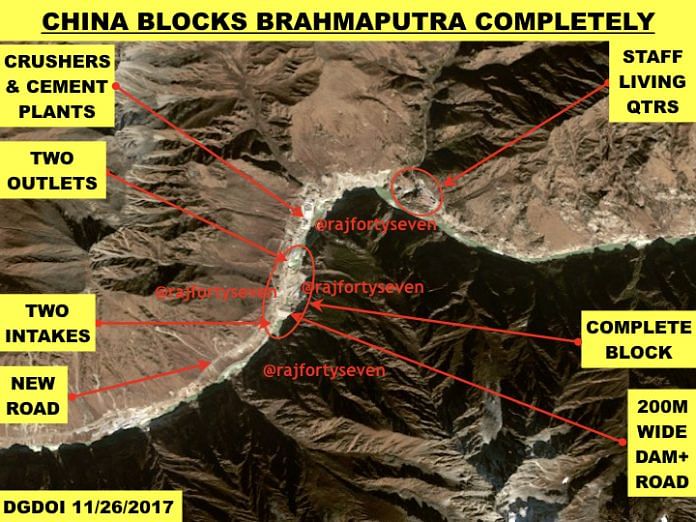Latest satellite imagery shows the river Brahmaputra disappearing into a 900 m underground tunnel in China.
In what is perhaps the first evidence of a possible diversion project by China, latest satellite imagery shows a massive new dam on the Brahmaputra river — Yarlong Tsangpo in Tibetan — with an underground tunnel that seems to engulf the entire water flow for almost one kilometre.
The Brahmaputra is sacred to Indians and Tibetans alike and has its origins in the Angsi Glacier in Purang county of Tibet. It has been in the news for water reportedly turning black on the Indian side and in connection with Chinese plans to divert it to the arid lands of the Taklamakan desert.
Although the Indian government has said that there is no evidence of any water diversion project, satellite imagery from 26 November 2017, courtesy US commercial vendor of space imagery DigitalGlobe, indicates a new project in an advanced stage. This report – based on latest satellite images — examines only the actual ground position. Measurements are made on very low resolution images and may not be exact.
New project
The available images show a new 200 m wide dam that seems to have completely blocked the water of the Brahmaputra. The entire river seems to be forced into two inlets of almost 50 m width each towards the west of the river. The water flow comes out after around 900 m downstream in two outlets very similar to the size and shape of the inlets.
The project – currently under construction – is located 60 km east of Shannan township as the crow flies. The location is also almost 40 km east of Sangri county.

What has raised questions about this project is that another project – Tsangmo or Zangmu Dam — has recently been constructed just 13 km downstream. This run of the river dam was made operational in end-2015 and has a capacity of 510 MW power production. Beijing did not pay any attention to India’s objections to the Tsangmo dam.
Possible diversion plan
The construction of another dam 13 km upstream of Tsangmo which diverts the entire water inside the mountain suggests that its purpose may not just be hydropower generation. The purpose of this project is possibly for diverting a portion of the Brahmaputra to the parched areas of Taklamakan desert.
The geography of the area, when studied deeply with the elevation profile, clearly indicates that China may actually be planning to divert the waters of the Brahmaputra approximately 1,100 km northwest of the project site.
The path indicated on the image below shows the possible route of the underground tunnel which does not touch any water body on its way. The height difference at the project site and the point of Taklamakan desert suggest that a clear downslope will be available for the water to flow naturally without any additional constructions for large storage wells in between.

India being downstream of the Brahmaputra has full rights over its waters and any diversion of water from this river could likely hurt Indian agriculture. During any emergency, a sudden release of water from this project can also cause havoc on the Indian side.
Black waters
Satellite imagery shows that polymer resin adhesives are being sprayed by China all around this project area as a dust suppressant system. The resin adhesives are commonly used for large construction projects but are never used for projects near water, according to some water projects construction engineers, since these polymer resin adhesives are said to be harmful to humans and animals.
The resin sprays have been observed over the last two months. The rough estimate of time for water flow to reach India from this project location is 15 to 20 days. The colour of the Brahmaputra water in Assam acquiring a darker shade, according to reports in the media, could possibly be due to the use of these resin adhesives at this project site.
Construction in full swing
Satellite images clearly show stone crushers and cement plants at the site. The products of this facility are obviously used inside these tunnels for construction purposes. The material being quarried from inside these tunnels is being piled along the river up to the road level. Most of the stones have been crushed to different sizes and some of it may be pushed into the river along with the water flow.
A large number of tippers and other vehicles are seen carrying material to and from this area. An administrative area is also seen east of the project with a large number of red-roofed houses and barracks, possibly living quarters for staff and may also contain administrative buildings.
This piece was first published on 13 December 2017.



